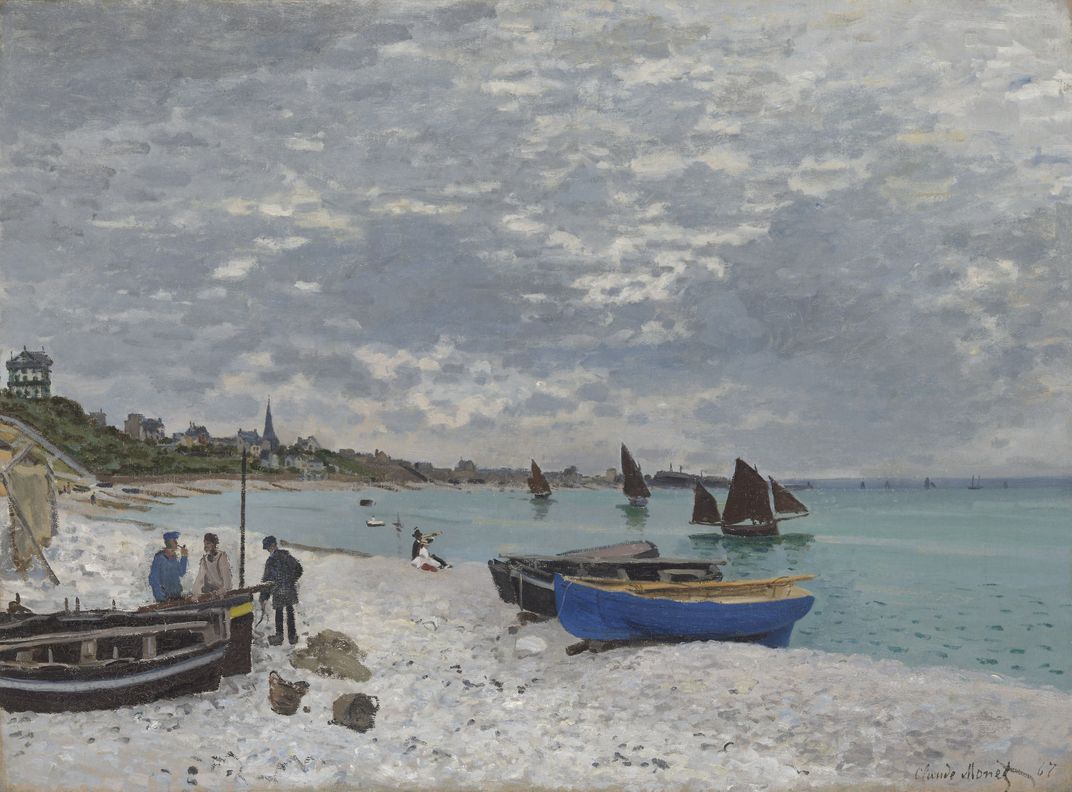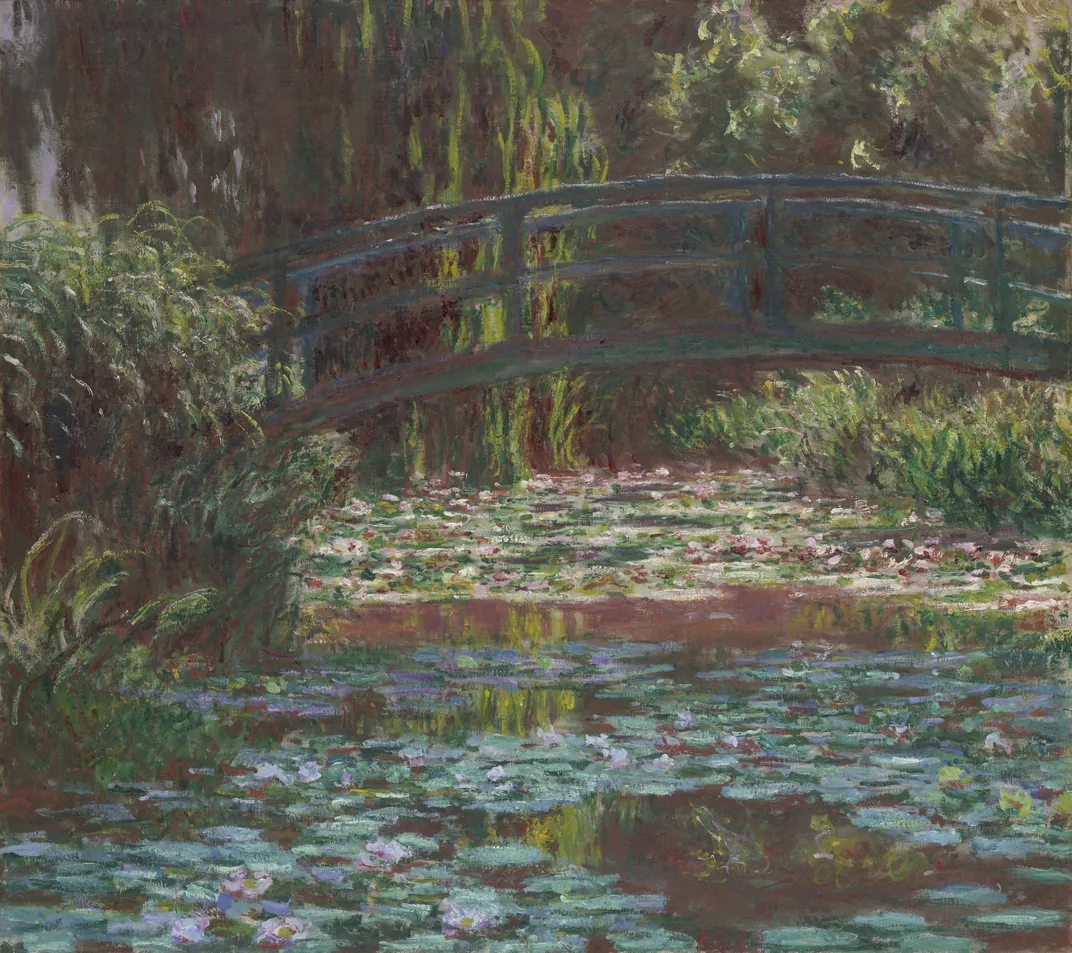How Chicago Became a Monet Destination
A new exhibition at the Art Institute of Chicago explores the Impressionist painter’s connection to the Midwestern city
:focal(1528x828:1529x829)/https://tf-cmsv2-smithsonianmag-media.s3.amazonaws.com/filer/e9/d8/e9d8dad3-be3a-4017-910a-5436bb43b932/19851103_-_stacks_of_wheat_end_of_summer.jpg)
Claude Monet’s en plen air studies of light dancing across fields and multi-colored fog have won Chicagoans’ admiration since the Impressionist painter’s works were first exhibited in the city in 1888.
“Why go to Paris since Paris has come to Chicago?” a reviewer wrote for the Chicago Daily Tribune at the time.
More than a century later, a 1995 Monet retrospective at the Art Institute of Chicago proved so popular that people flooded the Tribune’s classified ads in search of tickets to the sold-out show.
As Chicago Tribune art critic Steve Johnson points out, Monet never actually visited the Midwestern city. But thanks in large part to Chicago’s wealthy collecting class, the Art Institute now houses 33 paintings and 13 drawings by the artist—the largest trove of his works outside of Paris, according to a statement.
In “Monet and Chicago,” which opened this month with new social distancing guidelines in place, the Art Institute traces the unique connection between the French painter and the Illinois metropolis.
“There are many faces of the Art Institute, but people do associate Monet with us,” curator Gloria Groom tells the Chicago Sun-Times’ Kyle MacMillan.
The exhibition unites more than 70 works from both the Art Institute’s collection and private holdings. Per a blog post, paintings on view include gifts from such wealthy local collectors as Bertha and Potter Palmer, Martin A. and Carrie Ryerson, and Annie Swan Coburn.
In 1895, the Union League Club of Chicago paid $500 (around $15,500 USD today) for Monet’s Apple Trees in Bloom (1872); in doing so, notes the Tribune, the organization became the first Chicago institution to acquire a work by the artist. The Art Institute followed suit in 1903, becoming the first American museum to purchase a Monet painting with its acquisition of Bad Weather, Pourville (1896).
Visitors to the show can trace Monet’s career from his early beginnings as a caricaturist in Le Havre to the final stages of his life at Giverny, where he resided from 1883 until his death in 1926. Here, the artist increasingly fixated on his garden, pond and beloved Japanese footbridge, portraying the landscape in large-scale works of tangled blue, purple and green that approached abstraction.
“Monet and Chicago” also offers viewers the chance to examine six entries from the artist’s Stacks of Wheat series up close. Painted between 1890 and 1891, each depicts a simple pastoral scene in radically different light and atmospheric conditions. As Groom explains to the Sun-Times, the project marked Monet’s first foray into what would become a hallmark of his practice: painting the same thing over and over again in a serial format.
For Chicago collectors of this period, Monet’s loose brushwork and emphasis on painting outdoors represented a rejection of traditional modes of painting.
“They appealed to the well-heeled citizens of a city that saw itself as modern” and was continually striving to reinvent itself in the aftermath of the Great Chicago Fire of 1871, Groom tells WWTW’s Marc Vitali.
“When you’re looking at a Monet, you’re thinking of an artist who doesn’t use the intermediary of drawing to get to where he’s going. That was one of the innovations of the Impressionists, that they didn’t spend [their] time making careful drawings,” she adds. “… Everything looks like it was done in one go.”
Infrared and X-ray analyses of some of the Monet paintings in the Art Institute’s collections suggest the artist actually changed his compositions frequently, painting a rough draft of a work outdoors but later touching it up in his studio. These additions often rendered the painting completely different—for example, by adding or removing a second stack of wheat.
Monet worked and re-worked his compositions many times, adding layers of paint that contributed to a sense of atmosphere and texture, per the statement.
Chicago-based art lovers in search of additional Monet inspiration can stop by a companion show at the Garfield Park Conservatory & Gardens, where director of horticulture Peter Vrostros has curated a selection of plants like the ones that inspired Monet in his famous gardens at Giverny.
“Monet and Chicago” is on view at the Art Institute of Chicago through January 18, 2021. “The Flowers of Monet” is on view at the Garfield Park Conservatory & Gardens through November 30.
/https://tf-cmsv2-smithsonianmag-media.s3.amazonaws.com/accounts/headshot/nora.png)

/https://tf-cmsv2-smithsonianmag-media.s3.amazonaws.com/filer/f8/c9/f8c9ebd4-a4b9-49e5-a9f4-5bc19570a230/1922427_-_on_the_bank_of_the_seine_bennecourt.jpg)
/https://tf-cmsv2-smithsonianmag-media.s3.amazonaws.com/filer/43/37/43374a67-41b6-45b8-a418-a453d7a1ee5b/19331150_-_charing_cross_bridge_london.jpg)
/https://tf-cmsv2-smithsonianmag-media.s3.amazonaws.com/filer/41/47/41470e54-9f52-4e43-8a8c-0906bb6d4b60/19331156_-_branch_of_the_seine_near_giverny_mist.jpg)

/https://tf-cmsv2-smithsonianmag-media.s3.amazonaws.com/accounts/headshot/nora.png)